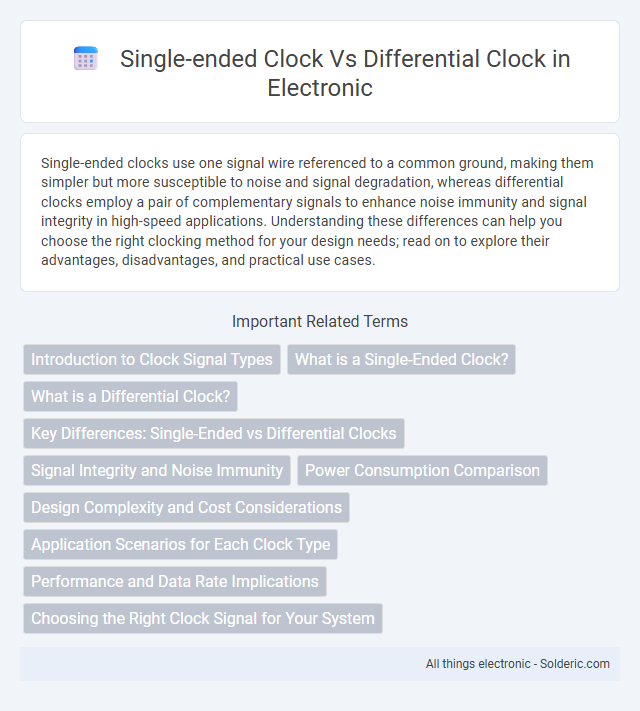Single-ended clocks use one signal wire referenced to a common ground, making them simpler but more susceptible to noise and signal degradation, whereas differential clocks employ a pair of complementary signals to enhance noise immunity and signal integrity in high-speed applications. Understanding these differences can help you choose the right clocking method for your design needs; read on to explore their advantages, disadvantages, and practical use cases.
Comparison Table
| Aspect | Single-Ended Clock | Differential Clock |
|---|---|---|
| Signal Type | One signal line referenced to ground | Two complementary signal lines |
| Noise Immunity | Lower, susceptible to EMI and crosstalk | High, cancels common-mode noise |
| Signal Integrity | Degrades over long distances | Maintains integrity over long distances |
| Power Consumption | Lower power consumption | Higher power consumption due to two lines |
| Complexity | Simpler, fewer components | More complex, requires differential receivers |
| Common Applications | Short distance, low-speed clocking | High-speed, long-distance clock distribution |
| Cost | Lower cost | Higher cost due to extra components and PCB routing |
Introduction to Clock Signal Types
Single-ended clocks transmit variations in voltage relative to a common ground, making them simpler but more susceptible to noise and interference in high-speed circuits. Differential clocks use two complementary signals, improving noise immunity and signal integrity by allowing receivers to detect the voltage difference between the two lines. These fundamental differences influence clock signal quality, electromagnetic interference (EMI) reduction, and overall system performance in timing-critical applications.
What is a Single-Ended Clock?
A Single-Ended Clock is a timing signal referenced to a common ground, using a single conductor to transmit the clock pulses. It typically suffers from higher susceptibility to noise and electromagnetic interference compared to differential clocks, affecting signal integrity in high-speed applications. Single-ended clock signals are simpler and cost-effective but are limited in performance for precision timing and long-distance transmission.
What is a Differential Clock?
A differential clock consists of two complementary signals transmitted over paired lines, providing improved noise immunity and signal integrity compared to single-ended clocks, which utilize a single signal referenced to ground. Differential clocks reduce electromagnetic interference (EMI) and crosstalk by balancing the signal, making them ideal for high-speed digital and RF applications. Common standards for differential clocks include LVDS (Low Voltage Differential Signaling) and CML (Current Mode Logic), enabling precise timing and synchronization in advanced communication systems.
Key Differences: Single-Ended vs Differential Clocks
Single-ended clocks use a single signal line referenced to ground, which makes them more susceptible to noise and electromagnetic interference, impacting signal integrity in high-speed applications. Differential clocks utilize two complementary signal lines, providing improved noise immunity and reduced electromagnetic emissions through signal cancellation. The choice between single-ended and differential clocks directly affects system performance, power consumption, and signal integrity in digital and communication circuits.
Signal Integrity and Noise Immunity
Single-ended clocks transmit signals via one conductor with a reference ground, making them susceptible to noise and signal degradation due to electromagnetic interference and ground shift. Differential clocks use paired conductors carrying equal and opposite signals, enhancing noise immunity by cancelling common-mode noise and improving signal integrity with reduced electromagnetic emissions. This differential signaling is crucial in high-speed digital systems where precision timing and robustness against interference are essential.
Power Consumption Comparison
Single-ended clocks generally consume more power due to their higher voltage swing and susceptibility to noise, requiring stronger driver circuits and larger signal regeneration efforts. Differential clocks offer lower power consumption by utilizing smaller voltage swings and improved noise immunity that reduces the need for additional power-hungry amplification. Your choice between the two affects overall system efficiency, especially in high-speed or low-power applications.
Design Complexity and Cost Considerations
Single-ended clock signals require simpler PCB layout and fewer components, resulting in lower design complexity and reduced manufacturing costs. Differential clock signals demand precise impedance matching and routing of paired traces, increasing design effort and overall expenses. Cost benefits of single-ended clocks are often offset by higher susceptibility to noise compared to the improved signal integrity of differential clocks.
Application Scenarios for Each Clock Type
Single-ended clocks are commonly used in low-speed digital circuits, consumer electronics, and simple timing applications due to their ease of implementation and lower cost. Differential clocks excel in high-speed data communication, telecommunications, and precision measurement systems by providing superior noise immunity and signal integrity. Your choice depends on the required signal quality, transmission distance, and environmental noise conditions.
Performance and Data Rate Implications
Single-ended clocks are susceptible to noise and signal degradation, limiting their maximum data rates and overall performance, especially in high-speed applications. Differential clocks provide better noise immunity and reduced electromagnetic interference (EMI), enabling higher data rates and more reliable timing signals. Systems using differential clocking typically achieve improved signal integrity and support faster data transmission compared to single-ended clock configurations.
Choosing the Right Clock Signal for Your System
Single-ended clock signals are simpler and cost-effective but more susceptible to noise and signal degradation over long distances, making them suitable for low-speed, short-distance applications. Differential clock signals offer improved noise immunity and signal integrity by transmitting complementary signals over two lines, ideal for high-speed and precision timing systems. Selecting the right clock signal depends on system requirements such as data rate, transmission distance, electromagnetic interference environment, and overall design complexity.
single-ended clock vs differential clock Infographic

 solderic.com
solderic.com